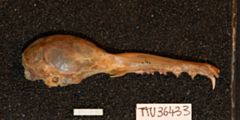Project 3449: L. Siles, R. S. Rios. 2019. Family Phyllostomidae Gray 1825 (Chiroptera): Summary 2000 to 2018. Special Publications, Museum of Texas Tech University. Book chapter (71):131-147.
Abstract
The bat family Phyllostomidae has undergone one of the largest known adaptive radiations among mammals; currently it is the second most diverse family of bats after Vespertilionidae and the most diverse with respect to feeding habits. Consequently, they play a vital role in ecosystem processes, which include forest regeneration, plant pollination, and insect predation. These characteristics make phyllostomids a fascinating group to study and current research is very dynamic. In this review, a summary of the state of knowledge regarding three main aspects is provided—rapid diversification, systematics, and recent taxonomic changes. First, the rapid diversification in the family is explored, and then the morphological, ecological, historical, and genetic processes that allowed this diversification to occur. Systematics and taxonomy in Phyllostomidae have been influenced by the intense molecular work carried out in recent decades. Early results showed that molecular and morphological phylogenies of Phyllostomidae were not congruent and revealed that feeding guilds were not necessarily monophyletic. Since then, numerous efforts have been made to resolve the family comprehensively and a discussion of the most recently published phylogenies is included. Taxonomically, new species have been described every year since the last revision in 2005, which resulted in a 34% increase in number of species, accounting for approximately 60% of all bats described in the Neotropics. A detailed review of these changes is presented, which includes described species, elevated subspecies or synonyms, and synonymized species. Taxonomic revisions were focused on only 10 of the 60 phyllostomid genera, thus research opportunities in this area are extensive. Future work promises to be equally intense to obtain an accurate description of the family’s diversity, define speciation patterns, provide an accurate taxonomy for ecological and behavioral studies, and delimit species distributions.Read the article »
Project DOI: 10.7934/P3449, http://dx.doi.org/10.7934/P3449
| This project contains |
|---|
Download Project SDD File |
Currently Viewing:
MorphoBank Project 3449
MorphoBank Project 3449
- Creation Date:
05 April 2019 - Publication Date:
05 April 2019 - Media downloads: 2

Authors' Institutions ![]()
- Universidad de La Serena
- Museo de Historia Natural Alcide d'Orbigny
Members
| member name | taxa |
specimens |
media | media notes |
| Lizette Siles Mendoza Project Administrator | 39 | 13 | 26 | 26 |
Project has no matrices defined.
Project downloads 
| type | number of downloads | Individual items downloaded (where applicable) |
| Total downloads from project | 159 | |
| Project downloads | 157 | |
| Media downloads | 2 | M662112 (1 download); M662111 (1 download); |

